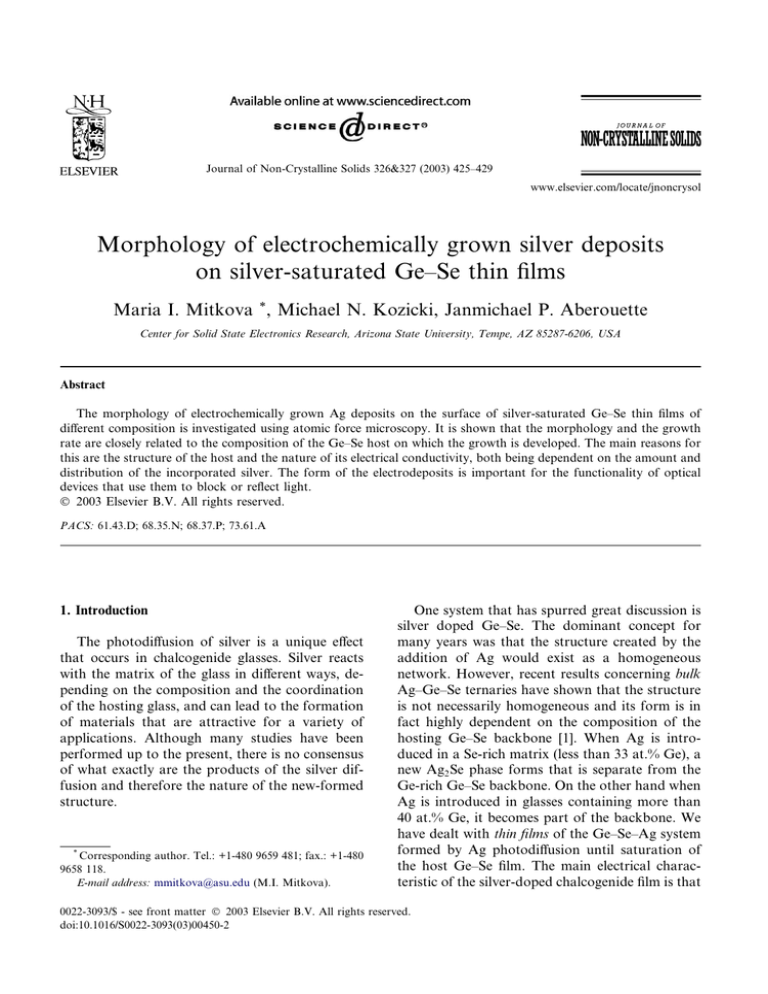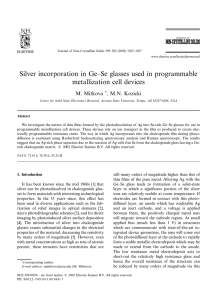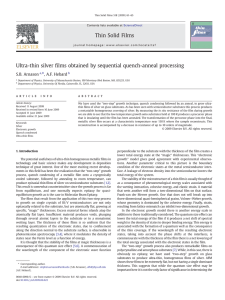
Journal of Non-Crystalline Solids 326&327 (2003) 425–429
www.elsevier.com/locate/jnoncrysol
Morphology of electrochemically grown silver deposits
on silver-saturated Ge–Se thin films
Maria I. Mitkova *, Michael N. Kozicki, Janmichael P. Aberouette
Center for Solid State Electronics Research, Arizona State University, Tempe, AZ 85287-6206, USA
Abstract
The morphology of electrochemically grown Ag deposits on the surface of silver-saturated Ge–Se thin films of
different composition is investigated using atomic force microscopy. It is shown that the morphology and the growth
rate are closely related to the composition of the Ge–Se host on which the growth is developed. The main reasons for
this are the structure of the host and the nature of its electrical conductivity, both being dependent on the amount and
distribution of the incorporated silver. The form of the electrodeposits is important for the functionality of optical
devices that use them to block or reflect light.
2003 Elsevier B.V. All rights reserved.
PACS: 61.43.D; 68.35.N; 68.37.P; 73.61.A
1. Introduction
The photodiffusion of silver is a unique effect
that occurs in chalcogenide glasses. Silver reacts
with the matrix of the glass in different ways, depending on the composition and the coordination
of the hosting glass, and can lead to the formation
of materials that are attractive for a variety of
applications. Although many studies have been
performed up to the present, there is no consensus
of what exactly are the products of the silver diffusion and therefore the nature of the new-formed
structure.
*
Corresponding author. Tel.: +1-480 9659 481; fax.: +1-480
9658 118.
E-mail address: mmitkova@asu.edu (M.I. Mitkova).
One system that has spurred great discussion is
silver doped Ge–Se. The dominant concept for
many years was that the structure created by the
addition of Ag would exist as a homogeneous
network. However, recent results concerning bulk
Ag–Ge–Se ternaries have shown that the structure
is not necessarily homogeneous and its form is in
fact highly dependent on the composition of the
hosting Ge–Se backbone [1]. When Ag is introduced in a Se-rich matrix (less than 33 at.% Ge), a
new Ag2 Se phase forms that is separate from the
Ge-rich Ge–Se backbone. On the other hand when
Ag is introduced in glasses containing more than
40 at.% Ge, it becomes part of the backbone. We
have dealt with thin films of the Ge–Se–Ag system
formed by Ag photodiffusion until saturation of
the host Ge–Se film. The main electrical characteristic of the silver-doped chalcogenide film is that
0022-3093/$ - see front matter 2003 Elsevier B.V. All rights reserved.
doi:10.1016/S0022-3093(03)00450-2
426
M.I. Mitkova et al. / Journal of Non-Crystalline Solids 326&327 (2003) 425–429
it can be regarded as a solid electrolyte in which
the conductivity has dual character electronic and
ionic [2]. We have used this film as active medium
for formation of programmable metallization cell
(PMC) memory devices, as well as a variety of
photonic and even microfluidic structures. The
structures based on PMC technology rely on the
formation of electrodeposited metallic elements
when a positive bias is applied to a silver anode in
a structure consisting of this anode, a silver-doped
chalcogenide film, and an indifferent cathode. By
changing the polarity of the applied bias the electrodeposit is dissolved and the material returns to
its original state. Because of the phase separated
structure of the silver doped solid electrolyte film,
the change from one condition to the other occurs
very rapidly.
The present paper relates to the morphology of
the silver deposits on which the function of optical
PMC devices rely. Optical PMC devices utilize
surface electrodeposits to block or reflect light and
therefore act as a light switch. Electrodeposit
morphology is discussed in terms of the composition and the structure of the hosting Ge–Se film.
This work is part of a general characterization and
optimization project regarding the materials aspects of the formation of PMC devices.
deposited without breaking vacuum using thermal
evaporation. The sample is then illuminated for 5
min with a light intensity of 4 mW/cm2 using a
Karl Suss Mask Aligner model MJB 3 with a
broadband (405 nm) source, to photodissolve the
silver into the chalcogenide film. These conditions
have been established to provide saturation of the
chalcogenide film with silver. The excess silver is
etched away using a solution of diluted iron nitrate
for one minute. Coplanar silver electrodes spaced
60 lm apart are patterned on the solid electrolyte
using OCG 825 photoresist and the Karl Suss
Aligner in a lift-off process. Silver is deposited with
the thermal evaporator and acetone is used to liftoff the unwanted silver.
The chalcogenide glass compositions that are of
interest in our investigations are: Ge20 Se80 ;
Ge30 Se70 ; Ge33 Se67 and Ge40 Se60 . The composition
of the Ag-saturated film was investigated using
Rutherford backscattering spectrometry (RBS)
analysis and viewed with scanning electron microscopy (SEM).
The electrodeposits were formed by applying a
0–5 V sweep with the Ag electrode as anode.
Morphology, height and area of the deposit were
established by atomic force microscopy (AFM)
using a Digital Instruments AFM-3 base with a
J-head detector in contact mode.
2. Experimental
3. Results
The structures that form the optical PMC devices were prepared in a following manner: The
process begins with a silicon substrate, used as a
mechanical support for the films, which is cleaned
by being submerged in Piranha etch for 5 min.
film of chalcogenide glass is
Once cleaned, a 300 A
of silver, which is
deposited followed by 150 A
The RBS analysis revealed that, as expected, the
photodiffusion changes the overall composition of
the films considerably (Table 1). As may be seen
from the table, different amounts of silver are introduced in the hosting films of different composition and the quantity of diffused silver diminishes
Table 1
Properties of the solid electrolytes used in the study
Initial
film composition
Film composition occurring
after Ag saturation of the hosting
chalcogenide glass
Amount of diffused
Ag at saturation
(at.%)
Maximal amount of Ag
introduced in bulk glass
(at.%)
Sheet resistance of the
silver doped film (ohms/
square)
Ge20 Se80
Ge30 Se70
Ge33 Se67
Ge40 Se60
Ge10:5 Se42:3 Ag47:2
Ge18 Se42 Ag40
Ge22:1 Se44:9 Ag33
Ge28 Se42 Ag30
47.2
40
33
30
33
32
20–30
25
2.2 · 103
4.3 · 104
1.2 · 106
1.6 · 108
M.I. Mitkova et al. / Journal of Non-Crystalline Solids 326&327 (2003) 425–429
427
Fig. 1. AFM images of surface electrodeposits on samples with Ag-saturated base glass compositions: Ge20 Se80 ; Ge30 Se70 ; GeSe2 ; and
Ge40 Se60 .
with decreasing Se concentration. The films are
non-homogeneous with nano-inclusions containing Ag – Fig. 1. One interesting point to note is
though that compared to the bulk material, a
much higher concentration of Ag can be introduced in the thin films by this technique.
The morphology of the deposit that grows when
the electric field is applied to the structure with
coplanar electrodes is shown in Fig. 1(a)–(d). One
can observe substantial differences in the shape
and growth kinetics of the electrodeposits and it is
clear that they depend on the composition of the
hosting glass.
4. Discussion
First we will discuss the formation of the material on which the growth of the silver electrodeposit takes place – the silver photodoped Ge–Se
428
M.I. Mitkova et al. / Journal of Non-Crystalline Solids 326&327 (2003) 425–429
films. The strong dependence of the amount of
diffused silver at saturation on the composition of
the glasses has been considered by Kluge et al. [3]
and Calas et al. [4] but no substantial explanation
has been given for the effect. The most important
result is that the photodiffused films are Ôchemically stableÕ, i.e., once saturated the composition
will not change with continued illumination. In
other words, the photodiffusion effect is self-limiting. We suggest that this is due to the intrinsic
nature of the structure that forms in the Ge–Se–Ag
system. In the Se-rich compositions, Ag reacts with
the free Se from the Se chains to form Ag2 Se that
phase separates from the Ge–Se backbone as in the
bulk material [5]. So the amount of Ag that the
system can adopt relates to the free Se available in
the glass. However at this point we should like to
mention one further detail – we expect that there
will be a slight difference in the Ag coordination
when it is alloyed with Se to form a glass by fast
quenching compared to when it is introduced by
photodiffusion occurring at room temperature.
Indeed, this difference in the Ag coordination has
been enumerated by Oldale et al. [6] in their extended X-ray absorption fine structure analysis.
We suggest that this is due to the fact that at
quenching of the alloyed glass, due to the high rate
of solidification, the solid phase that forms has a
short range order very close to the structure of the
high temperature form – a Ag2 Se, as also has been
noted by Barnes et al. [7]. In contrast, in the diffusion process the phase that forms is expected to
have a structure analogous to that of b Ag2 Se,
which is stable at room temperature. However our
XRD studies [8] reveal formation of both phases
due to space limitations. In addition, the defects
and metastable states in the chalcogenide that
occur during illumination with bandgap light can
also react with silver contributing toward considerable change of the structure of the hosting glass
as confirmed by our Raman spectroscopy data [9].
In this manner additional amount of Ag can be
introduced into the hosting Ge–Se glass.
For the Ge-rich glasses it has been shown [1]
that Ag becomes part of the backbone, reacting
with units with a distorted rock salt structure.
However at diffusion since this reaction requires
much more energy and the structure is much closer
packed, the silver photodiffusion is quite restricted.
The situation within the stoichiometric compositions is a intermediate one in which Ag can diffuse
in pores and volumes between the structural units
and react with some charged three-dimensional
units or Se defects formed due to the illumination
with light.
Now we turn to the electrochemical reaction of
the deposition of Ag on the Ag-saturated chalcogenide glass. The general nature of the morphology of these deposits apparently corresponds
closely to those reported in the literature in other
systems, particularly those formed by diffusioncontrolled processes such as diffusion-limited aggregation, first described by Forrest and Witten
[10]. However the nucleation points from which
the dendrites start to grow seem to be related to
the presence of excess Ag ions in the electrolyte
surface as in these regions the free energy for
formation of the electrodeposit will be lowest. In
the case of Ge20 Se80 glasses we have to bear in
mind that the glass structure is floppy [11] and the
illumination with light can cause considerable depolymerization of the Se chains [12]. As a result, a
number of randomly distributed charge defects
can occur in which the photodiffused Ag reacts to
form substantial Ag2 Se regions that later act as
nuclei for the formation of dendrites during the
process of electrochemical deposition. This is, in
our view, one reason that we see a great number of
randomly distributed Ag dendrites with small dimensions, covering the surface of the films and
barely forming an oriented morphology in the direction of the applied field. The electrons that have
to be supplied in order for Ag reduction to occur
originate from the cathode and can flow via the
growing dendrite, enabling deposition at any point
on the electrodeposit for which there is a local
supply of ions in the electrolyte.
In the case of Ge30 Se70 glasses, these have a
more stressed rigid structure [13] and illumination
with light cannot cause great redistribution of the
existing Se chains so the charged defects that form
are closely related to the chain structure of the
material. As a consequence, some orientation of
the electrodeposit occurs along regions which
contain these surviving chains. The same situation
also holds for the stoichiometric glasses. It should
M.I. Mitkova et al. / Journal of Non-Crystalline Solids 326&327 (2003) 425–429
be noted that these glasses have a completely different type of conduction [14] and their overall
conductivity is much lower (Table 1). In the case of
these materials, illumination of the hosting chalcogenide glass with light in the presence of silver
results in the formation of a structure that is
completely different from the initial one and occurrence of Ge-rich phases, containing Ge–Ge
bonds as well as Se chains as has been evident by
our Raman studies [11]. So, for these compositions
the morphology of the Ag deposits should have a
dual character – those formed over the Se chain
regions and those that grow over structures containing Ge–Ge bonds will be different in nature.
For bulk glasses formed by quenching of a melt it
has been shown that three component structures
form in the latter case that also include Ag in them
[1]. We assume that localized Ag-containing units
also occur in our thin films and can serve as nucleation centers that are fairly well insulated from
the rest of the film because of the heterogeneous
nature of the hosting Ge–Se glass [9]. These isolated nucleation centers are responsible for the
disjointed nature of the electrodeposits as the
growth rate is much higher in these regions. This
same process is especially well expressed for the
Ge-rich glasses, shown in Fig. 1(d). In this case the
hosting glass is thought to have n-type conductivity and one can expect that it also supplies
electrons in addition to the cathode for the reduction of the Ag ions and this greatly accelerates
electrodeposit growth.
5. Conclusion
In conclusion we would like to emphasize the
important role of the solid electrolyte medium on
429
which electrochemical deposition of metals such as
silver occurs. The structure of the silver-saturated
chalcogenide affects the morphology of the electrodeposited metal as well as the kinetics of the
process of electrodeposition on which the operation of optical programmable metallization cell
devices rely.
Acknowledgement
The authors would like to acknowledge the financial support of Axon Technologies Corp.
References
[1] M. Mitkova, Y. Wang, P. Boolchand, Phys. Rev. Lett. 83
(1999) 3848.
[2] M.N. Kozicki, M. Yun, S.-J. Yang, J.P. Aberouette, J.P.
Bird, Suprlat. Microstr. 27 (2000) 48.
[3] G. Kluge, A. Thomas, R. Klabes, R. Grotzschel, P.
Suptitz, J. Non-Cryst. Solids 124 (1990) 186.
[4] J. Calas, R. El Ghrandi, G. Galibert, A. Traverse, Nucl.
Instr. Meth. B 63 (1992) 462.
[5] Y. Wang, M. Mitkova, D.G. Georgiev, S. Mamedov, P.
Boolchand, J. Phys.: Condens. Matter 15 (2003) S1573.
[6] J.M. Oldale, J. Rennie, S.R. Elliott, Thin Solid Films 164
(1988) 467.
[7] A.C. Barnes, S.B. Lague, P.S. Salmon, H.E. Fisher, J.
Phys.: Cond. Matter 9 (1997) 6159.
[8] M.N. Kozicki, M. Mitkova, J. Zhu, M. Park, Microel.
Eng. 63 (2002) 155.
[9] M. Mitkova, M.N. Kozicki, J. Non-Cryst. Solids 299–302
(2002) 1023.
[10] S.R. Forrest, T.A. Witten Jr., J. Phys. A 12 (1972) L109.
[11] P. Boolchand, W. Bresser, Philos. Mag. B 80 (2000) 1757.
[12] A.V. Kolobov, S.R. Elliott, Adv. Phys. 40 (1991) 625.
[13] P. Boolchand, D.G. Georgiev, B. Goodman, J. Optoel.
Adv. Matter 3 (2001) 703.
[14] Z.U. Borisova, T.S. Rykova, E.Yu. Turkina, A.R. Tabolin, Inorg. Mater. 20 (1984) 1796 (in Russian).







